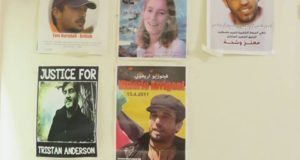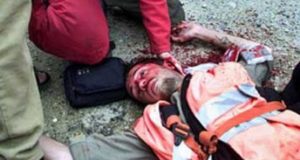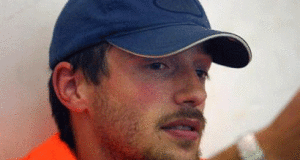By Joseph Algazy
Originally published by Haaretz
The family of an international peace activist, felled by an IDF bullet, hope they can help promote an end to the conflict
Tom Hurndall, a young Briton active in the International Solidarity movement, is lying unconscious at Soroka Medical Center in Be’er Sheva. Not long ago he was shot in the head by Israel Defense Forces soldiers in Rafah as he tried to get a 5-year-old girl out of the line of fire. The members of his family – his mother, Jocelyn, his father, Anthony, his sister Sophie and his brothers Billy and Freddy – are tending him at the hospital and hoping for a miracle. They are hurt and angry, but free of any hatred.
More than once they have returned to the place where he was injured. They visited the family of the Palestinian children whom Tom rescued from danger and took testimony from his friends and people who witnessed the incident. They are surprised to discover that the world media are evincing a great deal of interest in the affair, whereas in Israel it has hardly been mentioned. The IDF statement that was published after the incident is defined by the family as mendacious and they are demanding that an independent commission of inquiry uncover the truth of what happened. Thus far, the IDF authorities avoided speaking to them.
In Israel – this is their first visit to the region – the Hurndalls have been living in an apartment in Be’er Sheva put at their disposal by Israelis; in England they live in north London. The mother works in special needs education, the father is a solicitor. Tom, 21, is a student of photography at Metropolitan University. About a year and a half ago he visited Egypt and took a diving course. In February of this year he went to Baghdad. According to his father, Tom was interested in what is happening in the Middle East and wanted to document his experiences photographically while expressing opposition to the war in Iraq.
“Tom was in Iraq not as a pro-Iraqi, but as a human shield, like others who came from all over the world with the intention of stopping the war,” said Anthony Hurndall this week. “He is a young man with a great deal of intellectual curiosity who seeks the truth. He believed that there was no reason that the fate of a young Briton should be better than the fate of a young Iraqi living under the threat of war and wanted to share the risks with him in case of war. He is a thinking person. We are not members of any party or organization, but we are thinking people who take an interest in what is going on around us.”
Tom took many photographs during his stay in Iraq. According to his father, as the date of the attack on Iraq approached, the authorities asked the human shields to stay in eight or nine strategic locations, for example, water pumping stations and bus stations; for his part, Tom wanted to be in places where people might be exposed to danger, especially in hospitals. When he was not granted permission, he left Iraq and went to Jordan, but hoped to return to Iraq with an aid delegation. His wish was not fulfilled, and he stayed at a refugee camp on the Iraq-Jordan border, with people from various nations who had fled Iraq because of the war.
Seeking the truth
In Jordan, Tom found out about the International Solidarity movement and the activities of its members, who serve as a human barrier between the IDF and the Palestinians in the territories of the Palestinian Authority. He arrived in the West Bank accompanied by some of the people who had been in Baghdad with him and received training in non-violent resistance. On April 6, he went to Rafah. During his stay in Iraq, in Jordan and in Gaza, he kept in touch with his family and friends, and in letters to them from Rafah he described his experiences and sent photographs of protest demonstrations, masked armed men, funerals of people who had been killed – and mainly photographs of children playing.
He was shot on Friday, April 11. In the first reports that came out abroad it was said that he had been shot and killed, and only later on was it reported that he was very seriously injured. His father was outside of Britain when he received the news and within two days he came to Israel. The rest of the family followed him.
“Through the media and representatives of the British Embassy in Tel Aviv, we declared from the very first moment that we wanted to meet with anyone who was involved in any way in what happened to Tom in order to find out the truth,” says Anthony. “The intention was to [speak to] witnesses to the incident and representatives of the IDF. So far we have met with most of the International Solidarity activists who were with him in Rafah and with Palestinians who witnessed the incident. We read a statement by a South African photographer who was on the scene and we met with a local cameraman who works for an international news agency who photographed Tom before he was shot. Through British Embassy people we asked to meet official representatives of the IDF, to hear their version of the incident, but they refused to meet us. We were told that the IDF had begun an investigation of the incident.” In reply, Haaretz has been told by the IDF Spokesperson’s office that the military authorities will meet with the Hurndall family and that “upon the completion of the investigations and the formulation of conclusions, we will present them to the relevant people.”
Two days after the incident, the Hurndalls were shocked to read the IDF Spokesperson’s version in The Jerusalem Post, which stated that at approximately 17:00 an IDF position on the Israeli-Egyptian border, in territory under Israeli military control, identified a man of about 20 in camouflage uniform holding a weapon. According to the IDF version, the armed man opened fire, under cover of the building from which he had come out, at the nearby IDF position. IDF personnel fired a single bullet toward the armed man, the statement went on, and identified a hit. It must be noted, said the IDF statement, that this was the only shooting incident known to the IDF in that area at that time.
Indiscriminate fire
From the scraps of information the family has gathered on the ground, it emerges that Tom was wounded while he and his colleagues were at Haret al Barahne (the neighborhood of the Barhum family) in the Yibna refugee camp in Rafah, where Israel has erected a high wall. They were wearing bright orange vests and trying to get to the street at the end of which, every evening, the IDF positions a tank that fires automatic weapons indiscriminately at the street and the adjacent houses. The Palestinians believe that the purpose of the shooting is to frighten the inhabitants and force them to evacuate the area, thus creating an empty space between the wall the army built and the refugee camp.
Two days before the incident, Rushdie Jabr, 15, was wounded in the neck at the same spot by IDF fire. The following day, Mustafa Jabr, 20, was shot in the leg by IDF soldiers. The Hurndalls heard about the circumstances of the injuries to the two from their parents and their testimony was filmed on video.
According to eyewitnesses who have spoken to the Hurndalls, Tom and his friends saw a group of about 10 children playing in the street at which the IDF soldiers fired from a tank and from the tower on top of the wall. Some of the children ran away, but the little ones froze to the spot. Tom, wearing the bright orange vest, ran toward them, grabbed one of them and took him to a safe place. When he returned to get another little girl, he was shot. According to eyewitnesses, he was shot once by a sniper from the tower on top of the wall.
Initially he was taken to the Abu Youssef al-Najjar Hospital in Rafah, but as the means of treating him were not available he was then taken to the European hospital between Rafah and Khan Yunis. There too the medical staff could not treat him and finally, with the intervention of the British Embassy in Tel Aviv, he was transferred to Gush Katif and from there to Soroka Medical Center, three hours after he was wounded.
He arrived at Soroka in critical condition, with no pulse. His family was informed that the entry hole of the bullet that hit the left front side of his head was smaller than its exit hole in the lower back part of his head. According to his father, the doctors told him that Tom’s days were numbered; in the meantime his condition has stabilized, but he is still in a coma and his situation is defined as critical.
“I am angry at what has happened to Tom,” says his sister Sophie. “There is no justification for it. He came to the region to see what is happening here and to document the truth, and it makes me sad that they are spreading all kinds of lies about him; for example, the IDF statement that ostensibly he was wearing camouflage clothing and holding a weapon, while in fact he was wearing a bright orange vest and was not armed.”
Unlike Sophie, who knew about Tom’s plans and had even tried to discourage him from carrying them out, his younger brother Freddy did not know much about what he was doing in the region. Today, he says, he is proud of Tom. At the beginning of the week he and his mother visited Salem, 5, whom Tom rescued from the line of fire and who had played ball with him. According to Tom’s mother, Jocelyn, the little boy has not recovered from the trauma.
“Tom wanted to help the people here, and we also want to contribute in some way to finding a solution that will put an end to this conflict that is causing a lot of suffering, both to the Palestinians and to the Israelis,” says his father. “Like Tom, we are disgusted by wrongs and injustice and we have great empathy for oppressed people and want to help them. We feel great admiration for the Jewish people in Israel, but over the years, the stronger Israel has become, it has acted unjustly toward the Palestinians; we are disappointed. In the past I thought a lot about what is happening here, but I never imagined that I would be involved in it in any way. From now on this is also our responsibility, just as it is the responsibility of the Israelis and the Palestinians.”
Ever since she received word of her son’s serious injury, his mother has had a hard time falling asleep at night. “Again and again I go over in my head what happened. I’ve thought a lot about the conversation Tom related between him and a Palestinian named Mohammed a short while before his injury. Mohammed said that he had formed the impression that Tom was determined to stay in Rafah and help the Palestinian inhabitants. During the moments he tried to save the little children he acted with determination. Even when he was a boy of 9, his headmaster defined him as a thinking person who was determined to protect anyone who was vulnerable. Tom wanted to be a factor setting things moving by taking up a position on the front line and not being passive on the back bench.”
Quietly but clearly, she expresses her anger at those who injured her son. In her call to put an end to the lack of humanity and the oppression, Tom Hurndall’s mother notes that by using force, a great deal of force, Israel is removing itself from any framework of dialogue. “If I had to write a letter to the IDF, my letter would say: `Dear IDF, Please move on and let go of this negativity. Please meet us, allow an open dialogue, hear ordinary human anger, take responsibility where it is right that you do so, allow yourselves to be seen to be doing so. Allow this useless and perpetual dynamic of victimization to shrivel to nothing where it veritably belongs, so that your true qualities of intelligence, research in all areas can be appreciated, benefit the world and earn the international respect that will come your way. Please just put your head out of your faceless watchtowers and dark tanks and hear, feel, smell, breathe and taste the benefits of a more inclusive way of being.'”
 International Solidarity Movement Nonviolence. Justice. Freedom.
International Solidarity Movement Nonviolence. Justice. Freedom.


